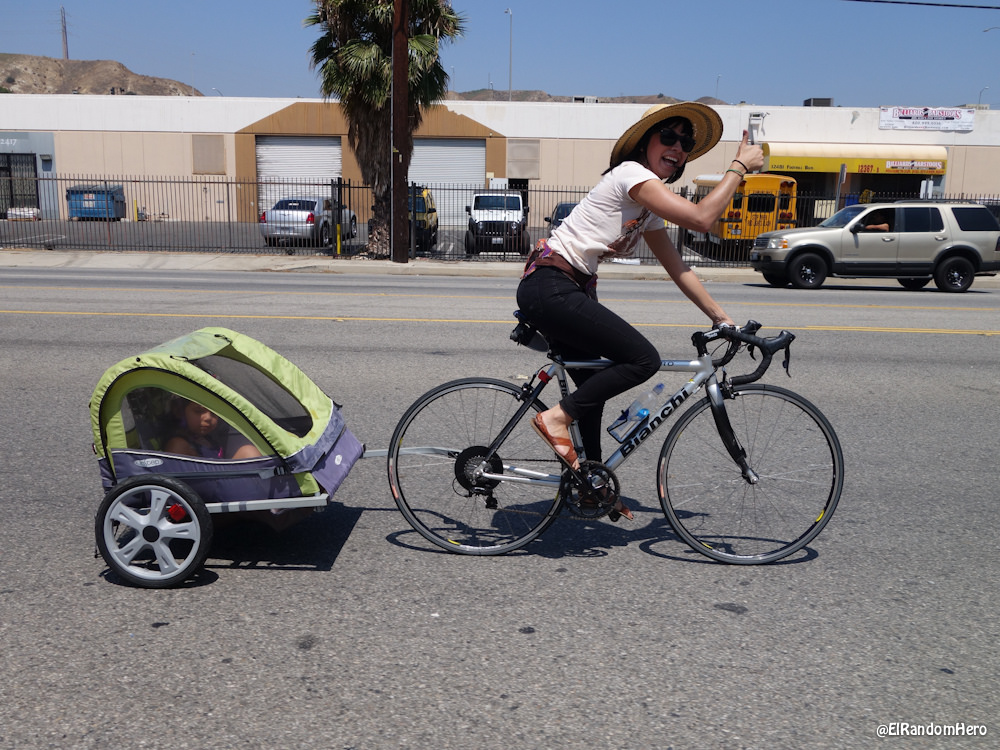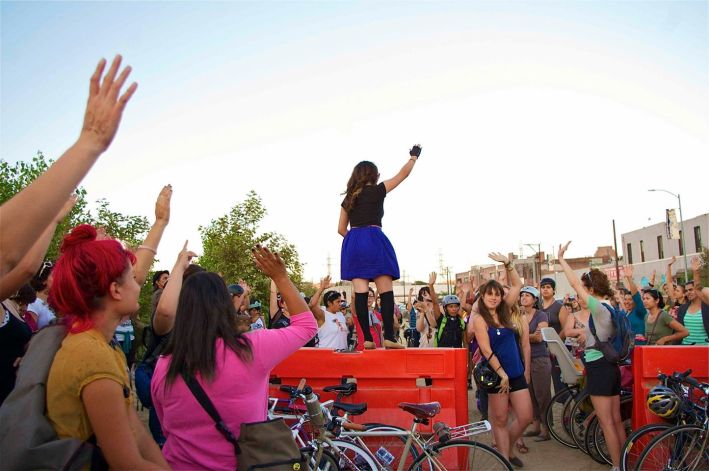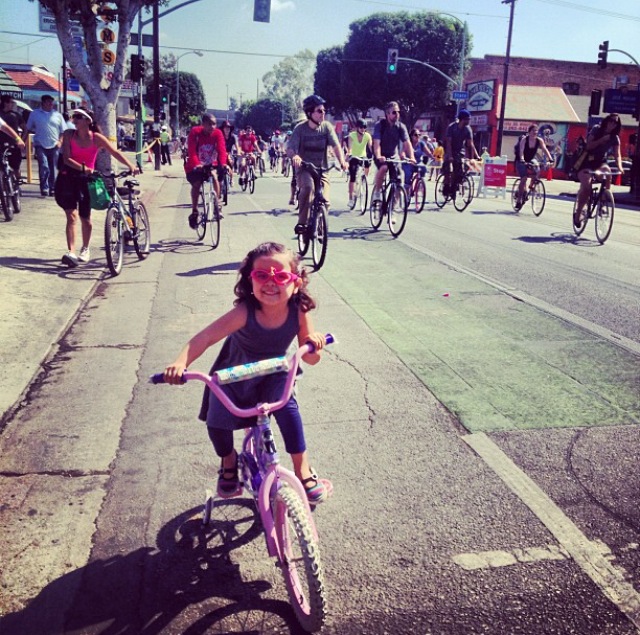#StreetsR4Families: Maryann Aguirre on Creating Safer Spaces for her Daughter
11:18 AM PST on December 19, 2014

Thumbs up. Photo: ##https://www.flickr.com/photos/justanotherrandomhero/14694260087/in/set-72157645931837518##Erick Huerta/Flickr##
“The first [bike] ride I took Leah on was the Black-Brown Unity ride two years ago,” says Maryann Aguirre, member of the Ovarian Psyco-Cycles Bicycle Brigade, a cycling group comprised of women of color based in Boyle Heights, “and I was f*cking dying!”
Pedaling the 12 miles the route wound between Boyle Heights and Watts with a heavy trailer and her then-5-year-old daughter in tow had proven tougher than she had anticipated.
While she laughs at the memory of how hard it was, I have to smile at the fact that the first ride she chose to take her daughter on was one aimed at building better relations between African-Americans and Latinos by raising awareness about their shared experiences with police brutality.
It makes perfect sense, really.
Although only 24, Aguirre has long been deeply engaged in making her community a better place. She is well-grounded in the concerns of the underprivileged, active in protesting gentrification, passionate about justice for people (particularly women) of color and willing to show up to fight for it, and, more recently, working to bring cycling and pedestrian infrastructure that fits the needs of existing residents to the working-class Latino community of Boyle Heights.
When I ask how she wants me to describe her, however, she balks at the confinement she feels sometimes comes with labels like “organizer” and “activist.”
“This is just something that I do because of the conditions I/we/she live(s) in, because of my existence,” she says. “To me, there is no other choice.”
“You are a conscientious community member with a passion for justice…” I try.
“…in my ‘hood,” she finishes, laughing.
Most of Aguirre’s actively practiced conscientiousness – even that around livable streets -- is oriented toward making the world a more welcoming space for her daughter, Leah Flores. Aguirre sees access to jobs and educational opportunities, affordable housing, a public space free of harassment from law enforcement or those carrying racial, gender, or other biases, and safe spaces for the expression of cultural and other identities as being integral to making a community and its streets healthier and, by extension, safer, more just, and more accessible for when Leah is ready to move through them on her own.
Which is probably the reason that, despite the fact that I am there to talk to Aguirre about the challenges of raising a child in a single-parent, car-lite household for Streetsblog’s #StreetsR4Families series, we spend the vast majority of our two-hour conversation on everything but her transit habits.

Not that she doesn’t think about mobility, of course. She does. A mother at age 17 in a lower-income community, she had no choice.
People often romanticize adopting a “car-free” lifestyle, she muses, when, “for people like me,” trips to the laundromat, grocery store, doctor, school made via transit, bike, or on foot, “that’s the necessity.”
But that doesn’t mean it is one she does not make the most of.
"I want [Leah] to know she doesn't have to accept that things are how they are," Aguirre told SBLA editor Damien Newton when she sat down with him a few months ago.
"Part of that is for her to know there's a lot of ways she can get around Los Angeles. She doesn't have to feel that she needs a car to go places." And part of that entails being intentional and using her rides with the Ovas, work on gentrification, and trips back and forth through different parts of town as educational opportunities to help Leah engage and process the world around her.
"Trips on the bus expose Leah to all sorts of people, many of whom are different than we are. It's a chance to show her that different doesn't mean bad, and how to relate to people that may not have as much as us," Aguirre explained.
She hopes it can help Leah both be grateful for the things they do have and aware of why others have not been so fortunate.
"Why is that man selling M&Ms? Why doesn't he sell them in a store?” she relayed a possible conversation about street vending. “It might seem like these are easy questions, but there's a lot a kid can learn from the way you answer."
It’s easiest for her to do that on transit, Aguirre tells me, expanding on what she had told Newton.
“[Leah] likes to be on the bus and the train more because she’s right there with me,” she says. “She’s really big on touching…so she loves to touch my ear and rub my arm, even when she goes to sleep. On the train, I’m right there with her. “
Plus, being stuck in a bike trailer for too long makes Leah antsy.
When Aguirre first got the trailer two years ago, Leah “would laugh and think it was fun when we would take trips to the laundromat because she would be squished in the trailer with a bag of clothes."

But as Leah has gotten older, she gets bored and annoyed if there isn’t much space to move around, which requires that Aguirre do a lot more packing and planning.
“Extra clothes, snacks, and things to entertain her because she gets bored. She’s going to be seven, but she looks like she’s four and she acts like she’s twenty. She’s a diva!”
Combining the two modes of transit – getting on a train with a bike trailer – is not a lot of fun. Trying to get the whole contraption into the station and onto the platform, spotting the car with the open space for bikes, and then navigating the bike and trailer around the people and poles inside the train car can be a tall order when she’s on her own.
Getting back and forth to the stations isn’t always that great an experience, either.
“They need a ‘Safe Routes to Metro,’” she jokes about the creative routes along side streets she takes when she has her child in tow, “not just ‘Safe Routes to School.’”
Which prompts me to ask about her more recent work with Multicultural Communities for Mobility (MCM) as a Promotora (someone who does outreach in the community around issues of interest).
The Ovarian Psycos, for all the visibility they have as a bike brigade, have generally stayed away from advocacy around more mainstream cycling issues. Aguirre’s involvement in engaging community members about bike lanes for Soto St. and Boyle Ave. (and any related concerns about gentrification bike lanes are sometimes thought to bring) is a step in a new direction.
Aguirre nods.
“[The Ovas] cycle, but we’re not part of the bigger ‘bike culture,’ either.“
That had been made abundantly clear to them by the backlash they experienced when they held their first “Clitoral Mass” ride for “womyn and womyn-identified folx” three years ago. Male riders (sometimes angrily, sometimes aggressively) questioned the need for a “safe space” for women and called the ride discriminatory against men.
Even though these comments came from a minority of disgruntled guys within the cycling community, it helped cement the Ovas’ sense they were onto something when suggesting that the prevailing bike culture wasn’t as open to people of color, women, and women of color or the unique issues they face as those inside that community had assumed it was.
But part of the Ovas’ distance from the bike community also had to do with where bicycles fit into the larger functioning of the organization. The core strength of the group lies in the sisterhood, the breathing room the group gives members to shatter the constraints imposed upon women of color and discover their identities, and the support they give each other as they work to overcome the struggles they share. Bikes are the tools that bring them together and get them out into their community in a way that helps them feel autonomous while bringing positive visibility to the issues they are trying to address.
As we talk about how the linking of cycling to larger issues of justice and equity that can impact access to streets seems to be something that marks a major difference in the way those from lower-income communities of color approach advocacy, Aguirre laughs and asks if she is a “bad L.A. cyclist” because she can’t separate them out.
Hardly.
It’s just a different definition of a “cyclist” than we’re used to seeing in advocacy circles.
But it's also one that may be gaining more traction. Adonia Lugo, Elizabeth Murphy, and Carolyn Szczepanski recently published an equity report for the Equity Initiative of the Bicycle League describing a number of groups and advocates from across the country who incorporate justice into their work. The Los Angeles County Bicycle Coalition just hired an executive director, Tamika Butler, with an extensive history in advocacy for justice for the underprivileged and people of color. The United Riders of South L.A. use bikes as an organizing tool to keep youth active, safe, out of gangs, and making positive contributions in their communities. And Aguirre, along with other members of the Ovas and MCM, have been successful in convincing cyclists from their communities to begin to engage urban planning and development issues in a way that traditional planning outreach efforts have not.
When I suggest that she’s been instrumental in raising the visibility of those often considered to be “invisible” cyclists and of other approaches to both cycling and advocacy, she shrugs, slightly embarrassed. She doesn’t really like talking about herself or what she has accomplished.
She is motivated by her own struggles, those of women and the community members around her, and the desire to create safer spaces for her daughter, she says.
This is, she repeats, “my existence. To me, there is no other choice.”
Stay in touch
Sign up for our free newsletter
More from Streetsblog Los Angeles
Metro Board Funds Free Student Transit Pass Program through July 2025
Metro student free passes funded another year - plus other updates from today's Metro board meeting
Eyes on the Street: New Lincoln Park Avenue Bike Lanes
The recently installed 1.25-mile long bikeway spans Lincoln Park Avenue, Flora Avenue, and Sierra Street - it's arguably the first new bike facility of the Measure HLA era




